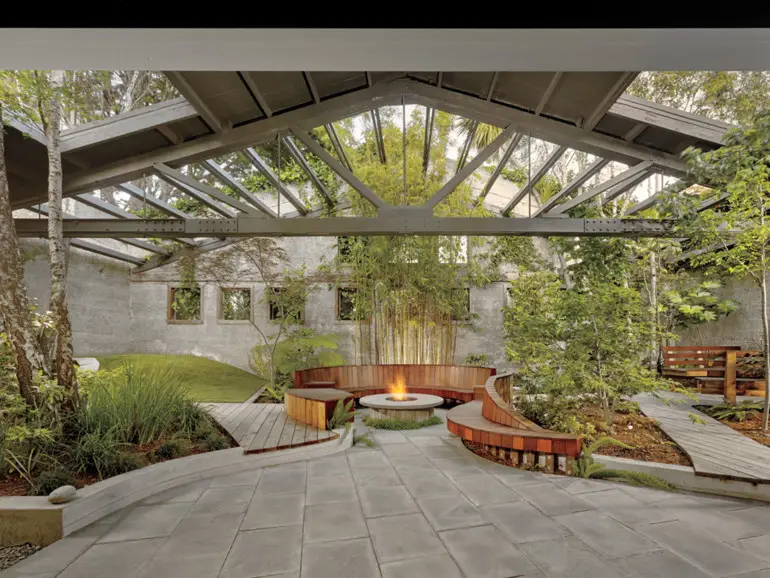This office garden is one designer’s living room.
WHEN SAN FRANCISCO LANDSCAPE DESIGNERS John and Danielle Steuernagel of Sculpt Gardens teamed up with Seth Boor of the architecture firm Boor Bridges to design an artful office for Chris Miksovsky in 2016, they could not have hoped for a more collaborative client.
Miksovsky’s product design company, called humangear, devises clever tubular travel and camping containers such as the immensely successful Gotoob. Humangear’s office in a single-story 1918 horse-and-carriage shop in the Haight-Ashbury district still contained the tiny cubicles installed by the previous owner, a music promoter, and Miksovsky was ready to make changes.

An avid outdoorsman, he wanted an open-plan office with a workshop for making prototypes, plus a back garden that permeated the interior as well. He wanted the garden to be a place for humangear’s team to brainstorm but also a restorative spot for meditation. “After a weekend of mountain-biking, backpacking or motorbiking, he also wanted to swing straight into work if deadlines called for it,” Boor recalls.
So a full-fledged shower and a backyard grill also became part of the unusual program for this industrial-design hideout. What evolved within a few months is a kind of 4,000-square-foot live/work space with a 2,000-square-foot back garden that blurs the lines between recreation and creation.
A large green garage door opens into the foyer so Miksovsky can roll in on his bike. Inside, humangear’s happy crowd can look out at nature through roll-up glass doors in back.
While this is not the first office Sculpt Gardens has worked on, it is the first time they were asked to install custom wood-clad steel planter boxes between desks as dividers. The boxes have an irrigation and drainage system; mounted on casters, they can be unhooked from their water supply and rolled out for air into the backyard, where the Steuernagels have created a year-round wonderland.

“There was already a 1980s garden back there,” Danielle Steuernagel says. “During the ’60s, someone had removed the rear section of the building roof and parts of the concrete floor and installed a garden filled with bamboo, camellias and palm-like Cordyline australis. It was completely overgrown and falling apart.”
Still, Boor Bridges reinforced the open sections of the old roof and added new truss beams protected with layers of paint; the Steuernagels saved some of the old garden, including birch trees, pruned to fit the new landscape they created.
“There was a vine that had engulfed the whole building and we had to get a demolition crew to eradicate it but we could not totally get rid

of it,” John Steuernagel says. “It is a maintenance job because it sort of trails in now and then. That’s why in our low-maintenance gardens we try to avoid vines that can establish hidden roots.”
On the east side, a raised mound, which the designers call Hippie Hill — an homage to the Summer of Love — is made up of old concrete and other rubble that came out of the former garden, and it is all covered with artificial drought-conscious Forever Lawn. Around it, Miksovsky suggested outdoor seating where humangear employees could work and lounge, along with raised paths where they could walk while thinking of new ideas. The Steuernagels and their small design/build team immediately thought that a sculptural, organic form could anchor the center of their design.

In their plan, they drew interlocking circles inspired by humangear’s logo and eventually created circular redwood boardwalks that blend into a circular ipe wood bench made up of hand-built components. The bench surrounds a circular gas fire pit composed of repurposed granite curbstone. Instead of concrete, the rest of the garden is now covered with bluestone pavers that are laid at a 13-degree angle to align with a pattern in the interior carpeting. “It is more obvious when the back roll-up doors are open,” Boor says.
Add a glass dry-erase board hanging on one of the building’s old 20-foot-high sandblasted concrete perimeter walls that form a fence around the garden, and even a built-in barbecue at one end, and you have every humangear employee’s dream garden. Staffers frequently lunch together outside and every Friday, even on foggy days, the fire pit is the locus of cocktail parties.
“Before this garden, we never really thought that people at work also need to be outside just as we do at home,” Danielle Steuernagel says. “This is an extension of home. Chris loves to entertain his friends here because his apartment nearby is smaller. On days when he rolls in right after dirt biking, there is a hot shower and a garden waiting.”

